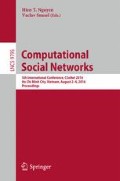Abstract
When two social groups merge, members of both groups should socialize effectively into the merged new entity. In other words, interpersonal ties should be established between the groups to give members appropriate access to resource and information. Viewing a social group as a network, we investigate such integration from a computational perspective. In particular, we assume that the networks have equipotent nodes, which refers to the situation when every member has equal privilege. We introduce the network integration problem: Given two networks, set up links between them so that the integrated network has diameter no more than a fixed value. We propose a few heuristics for solving this problem, study their computational complexity and compare their performance using experimental analysis. The results show that our approach is a feasible way to solve the network integration problem by establishing a small number of edges.
Access this chapter
Tax calculation will be finalised at checkout
Purchases are for personal use only
References
Aguilera, R., Dencker, J., Yalabik, Z.: Institutions and organizational socialization: integrating employees in cross-border mergers and acquisitions. Int. J. Hum. Resour. Manag. 15(8), 1357–1372 (2006)
Albert, R., Barabasi, A.-L.: Statistical mechanics of complex networks. Rev. Mod. Phys. 74, 47 (2002)
Baker, M.: Peer-to-Peer Leadership: Why the Network Is the Leader. Berrett-Koehler Publishers, San Francisco (2013)
Burt, R.: Structural holes and good ideas. Am. J. Soc. 110(2), 349–399 (2004)
Casella, E.: The Archaeology of Plural and Changing Identities: Beyond Identification. Springer, New York (2005)
Danziger, M., Bashan, A., Berezin, Y., Shekhtman, L., Havlin, S.: An introduction to interdependent networks. In: Mladenov, V.M., Ivanov, P.C. (eds.) NDES 2014. Communications in Computer and Information Science, vol. 438, pp. 189–202. Springer, Berlin (2014)
Jackson, M.: A survey of models of network formation: stability and efficiency. In: Group Formation in Economics, pp. 11–57. Cambridge University Press, Cambridge (2005)
Leskovec, J., Kleinberg, J., Faloutsos, C.: Graph evolution: densification and shrinking diameters. ACM TKDD 1(1), 2 (2007)
Liben-Nowell, D., Kleinberg, J.: The link prediction problem for social networks. In: Proceedings of CIKM, pp. 556–559 (2003)
Liu, J., Moskvina, A.: Hierarchies, ties and power in organisational networks: model and analysis. In: Proceedings of ASONAM, pp. 202–209 (2015)
Lokshtanov, D., Misra, N., Philip, G., Ramanujan, M.S., Saurabh, S.: Hardness of r-dominating set on graphs of diameter (r + 1). In: Gutin, G., Szeider, S. (eds.) IPEC 2013. LNCS, vol. 8246, pp. 255–267. Springer, Heidelberg (2013)
Moskvina, A., Liu, J.: How to build your network? a structural analysis. In: Proceedings of IJCAI 2016, AAAI Press (2016, to appear)
Newman, M., Watts, D., Strogatz, S.: Random graph models of social networks. Proc. Natl. Acad. Sci. USA 99, 2566–2572 (2002)
Padgett, J., Ansell, C.: Robust action and the rise of the medici, 1400–1434. Am. J. Sociol. 98(6), 1259–1319 (1993)
Ritter, T., Wilkinson, I., Johnston, W.: Managing in complex business networks. Ind. Mark. Manage. 33(3), 175–183 (2004)
Robertson, B.: Holacracy: The New Management System for a Rapidly Changing World Hardcover. Henry Holt and Co., New York City (2015)
Wang, X., Chen, G.: Complex networks: small-world, scale-free and beyond. IEEE Circ. Syst. Mag. 3(1), 6–20 (2003). First Quarter
Author information
Authors and Affiliations
Corresponding author
Editor information
Editors and Affiliations
Rights and permissions
Copyright information
© 2016 Springer International Publishing Switzerland
About this paper
Cite this paper
Moskvina, A., Liu, J. (2016). Integrating Networks of Equipotent Nodes. In: Nguyen, H., Snasel, V. (eds) Computational Social Networks. CSoNet 2016. Lecture Notes in Computer Science(), vol 9795. Springer, Cham. https://doi.org/10.1007/978-3-319-42345-6_4
Download citation
DOI: https://doi.org/10.1007/978-3-319-42345-6_4
Published:
Publisher Name: Springer, Cham
Print ISBN: 978-3-319-42344-9
Online ISBN: 978-3-319-42345-6
eBook Packages: Computer ScienceComputer Science (R0)

